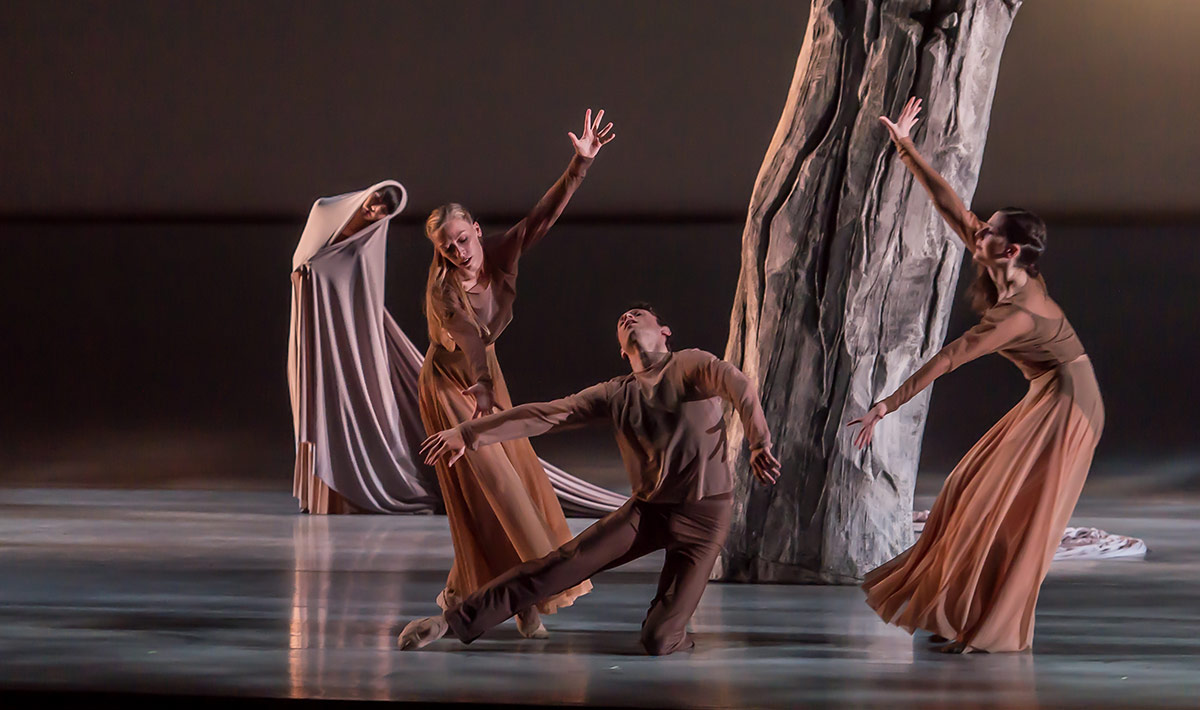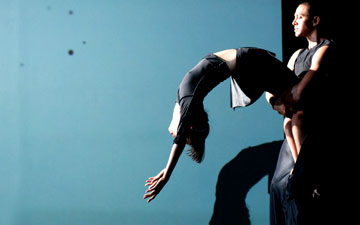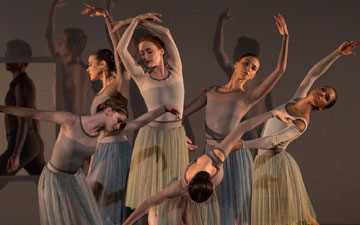
© Kevin Yatarola. (Click image for larger version)
Jessica Lang Dance
White Light Festival: Stabat mater
★★★★✰
New York, Rose Theater
2 November 2017
www.jessicalangdance.com
www.lincolncenter.org/venue/rose-theater
Despite the fact that Christians make up about a third of today’s global population, compared to the days of martyrs and mystics, Western society today feels largely secular. In this climate, it is a brave and interesting thing to see a contemporary artist go deep into the realm of the sacred. Taking her lead from Pergolesi’s sublime “Stabat mater,” Jessica Lang does not shy away from the treacherous terrain of Catholic sorrow, and the result is full of power and mastery.
Lang’s first iteration of Stabat mater premiered in 2013 at the Glimmerglass Festival in Cooperstown. This November saw the Big Apple’s premiere as part of the White Light Festival.
Central are the singers – countertenor Anthony Roth Costanzo and soprano Andriana Churchman – who weave in and out of the dancers on stage, and are accompanied by the Orchestra of St. Luke’s (as conducted by Speranza Scappucci). The singers are asked a lot too: on more than one occasion, Costanzo arches back on half point, almost in a semi-circle, in a feat of amazing abdominal control, in another, Churchman lies down while singing. The effect of the singers and dancers moving together is deftly managed by Lang. Pergolesi’s music – a liturgical sequence set to poetry describing Mary’s suffering at the cross – is complex, frequently dissonant and eerie. As if the topic wasn’t grim enough, Pergolesi composed “Stabat mater” on his deathbed, in the grip of tuberculosis, which took his life at the untimely age of just 25.

© Karli Cadel. (Click image for larger version)
The opening image of Stabat is striking: a woman stands alone, draped in a long blue cloth, at the foot of a giant, gnarled tree trunk which hovers above the stage. There is no denying the subject matter.
As a choreographer, Lang is nothing if not sculptural, and this first vision – one of many similar moments throughout the 40-minute work – strikes a chord which resonates with the rich history of art, religion and the interaction of these worlds. The vast swathe of fabric transforms the woman into a statuesque figure of momentous proportions, the rippling cloth something from a sculpture by Raffaele Monti or annunciation images from Fra Angelico. Fabric is key to the work, and the virginal drapery gets shared among the dancers so that there is no one “Mary.” Fabric is transformative in Stabat, sometimes pulling dancers across the stage or draped across one of the gargantuan beams, echoing the post-death imagery of the cross, barren of Christ’s body but reminding the faithful of his presence through the resurrection.
The first movement, Stabat Mater dolorosa, is a piercing cry of mourning in F minor (the 12-movement work returns to this key at its conclusion). Originally set for an alto and soprano, Costanzo’s countertenor voice is astonishing, as is Churchman’s not-always-tranquil pleas. The fantastic acoustics at the Rose made their voices, and the orchestra, sound both rich and clear.
The solitary female figure of the opening is shortly joined by the rest of the troupe. Dancers cluster downstage and alternate between standing and stooping in fetal positions. Bodies pulse gently up and down on half point in tandem with the music, and the effect is startlingly moving. The second movement, which features the lyrics “pierced by the sword,” sees dancers thrusting an imaginary sword into their abdomen, their bodies flexing forward and back in pulsating, whiplash motions. In a gentler way, there is much folding and unfolding in Lang’s work, though not of the grotesque, knotted kind. A dancer cowering under a lowering beam slowly reverses her role after another dancer joins her – he lowers himself as she rises up before arching backwards over his curled body. Développées are long and luscious, and there is an equal balance of poses both protected and powerless (such as the fetal position), and the expressive. In the brisk sections of the score (believe it or not, there are some), dancers frolic, skip and spin, their wrists flicking and fingers flailing. Even waltzing makes an appearance, and something akin to maypole dancing, with many rotations around the cross.

© Kevin Yatarola. (Click image for larger version)
Lang’s musicality and modern references are a delightful combination, and shadows of Morris, Taylor and Tudor flicker throughout the piece, but as with the last work of hers I saw (Her Notes) there can be too much happening – though all of it looks beautiful. While watching one group of dancers stage right, a pas de deux can be missed stage left. It does not look cluttered, and perhaps it was the intimacy of the Rose theater, but it was easy to not see everything presented in this piece, but maybe that is as it was meant to be.
In the sixth section, Lang utilizes the pieta pose of “Mary” hovering over her son and cradling him. Later on, an upside down version of the Corpus of Christ appears, as a young male dancer lies on his back upstage, his feet up against a wall, his knees bent and arms outstretched. In another section, dancers line up and pray over one of the beams, now fully lowered downstage.
Despite Lang’s program note commentary (‘we can remove the identities of these figures and what remains is a universal story of love and loss’) she fully embraces traditional tropes and visualizations of Christian imagery. There is a deconstructed cross. Over the course of the work, the gauzy blouses of the dancers change from brown to blue, the Madonna’s signature color. There are prayer poses. There are arms outstretched like Christ, and there is direct, physical interpretation of some of the lyrics. With music this powerful, written with such purpose, why not? There is no refuting the Church’s role in Western art and history, and taken from a secular standpoint, the Christ story is one of the world’s epic tales. Some may take issue with the literal here, but in many ways it makes Lang’s choreography stronger, as something in dialogue with religion, faith, art, imagery and history. As a figure who knew her entire life that she would outlive her child, Mary’s suffering is, in her foreshadowing at least, unique, and Stabat mater makes one feel the weight of it.

















You must be logged in to post a comment.